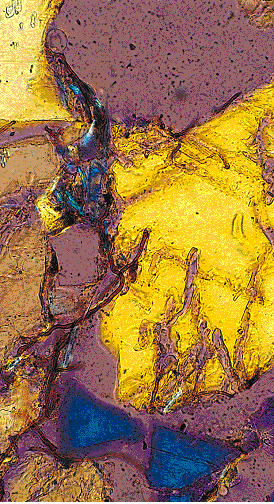Jongmans,A.G., van Breemen,N., Lundstrom(oの頭に¨),U., van Hees,P.A.W., Finly,R.D., Srinivasan,M. and
Unestam,T., Giesler,R., Melkerud,P.-A. and Olsson,M.(1997): Rock-eating
fungi. Nature, 389, 682-683.
『岩石を食べる菌類』
『Weatherable minerals under many European coniferous forests
contain a network of numerous tubular pores, formed by organic
acids exuded by fungi. We believe that symbiotic mycorrhizal hyphae
translocate dissolved minerals from the isolated micropores directly
to their host plants, bypassing competition for nutrient uptake
by other organisms. The discovery of this pathway challenges current
ideas about nutrient uptake from the bulk soil solution and criteria
for critical loads of acidic deposition on forests.』
『多くのヨーロッパの針葉樹林下にある風化可能な鉱物には、菌類により滲出された有機酸によって形成された多数の管状の細孔が、網状にはりめぐらされている。共生菌根菌糸がその隔離された微小孔から溶解したミネラルを、他の生物による栄養摂取との競争を回避しながら、直接それらの親植物に転流させていると、我々は信じている。この流路の発見は、全体的な土壌溶液からの栄養摂取ならびに森林への酸性降下物の臨界負荷に対する基準について、これまで受け入れられている考え方に問題を提起している。』
『Pores of width 3-10μm, which sometimes contain fungal hyphae,
are widespread in feldspars (Fig. 1, 2) and hornblendes
in podzol E soil horizons and granitic bedrock under Pinus
sylvestris(ヨーロッパアカマツ), Picea abies(ヨーロッパトウヒ) and ericaceous
shrubs in Sweden, Finland, Denmark, the Netherlands and Switzerland.
Micropores are rare in deeper podzol horizons and in acidic brown
forest soils (Cambisols). We believe that the pores were formed
by mycorrhizal or saprotrophic fungi, which exude organic acids1)
from their hyphal tips. Such acids enhance mineral weathering
by forming complexes with aluminium.』
『ときどき菌糸を含むような幅3〜10μmの細孔が、スウェーデン・フィンランド・デンマーク・オランダ・スイスのヨーロッパアカマツ・ヨーロッパトウヒ・ツツジ科低木の下にある、ポドゾルE土壌層と花崗岩質基盤岩中の長石(図1、2)と普通角閃石中に広く存在する。微小孔はポドゾル層の深部や酸性褐色森林土(カムビソル)には稀である。我々は、これらの細孔は、菌糸尖端から有機酸を滲出する菌根菌または腐食菌により形成されたと信じている。そのような酸は、アルミニウムと錯体を形成することによって鉱物風化を促進する。』

Figure 1 Thin-section micrograph in cross-polarized
visible light with 550-nm retardation (gypsum plate), showing
an alkali feldspar from a podzol E soil horizon (yellow) with
micropores (purple) and 5-μm-thick fungal hyphae (brown).
図1 550nmのレターデーション(石膏検板)を加えた十字ニコル下での薄片写真で、微小孔(紫色)と5μmの厚みの菌糸(褐色)を伴う、ポドゾルE土壌層からのアルカリ長石(黄色)を示す。 |

Figure 2 Scanning electron micrograph, showing 4-6-μm-thick
hyphae entering a calcium feldspar at a granite surface near
Lunsen, Sweden.
図2 スウェーデンのルンセン近くの花崗岩表面にある、カルシウム長石へ侵入している4〜6μmの厚みの菌糸を示す走査電顕写真。 |
『We found micro- to millimolar concentrations of succinate(琥珀酸塩),
citrate(クエン酸塩), oxalate(蓚酸塩), formate(蟻酸塩)
and malate(りんご酸塩) in Swedish bulk soil solutions. Concentrations
are likely to be higher near hyphal tips inside the pores. Fungal
hyphal tips producing millimolar concentrations of these acids
could dissolve calcium-rich plagioclase feldspars to form pores
at rates of 0.3-30 μm yr-11). From total-element
soil analyses, we calculated losses by weathering in one Swedish
soil (assuming zirconium to be inert2), and infer that
〜150 m of pores are formed annually per dm3 of E horizon,
and that about 107 hyphal tips are eating their way
through sand grains at any one time. Each feldspar grain would
contain several active hyphal tips, but less than 1% of all pores
would contain hyphae. These values are consistent with our micromorphological
observations in podzol E horizons.』
『スウェーデンの総土壌溶液中に、マイクロ・モルからミリ・モルの濃度の琥珀酸塩・クエン酸塩・蓚酸塩・蟻酸塩・りんご酸塩を、我々は見出した。細孔内の菌糸尖端近くで、おそらく濃度は高い。ミリ・モル濃度のこれらの酸を生成する菌糸尖端は、カルシウムに富む斜長石を溶解して、0.3〜30
μm/年の速度で細孔を作れるだろう。全元素土壌分析から我々は、あるスウェーデンの土壌において風化による損失を計算し(ジルコニウムは不活性と仮定して)、年間〜150
m の細孔がE層のdm3当りで形成され、およそ107 の菌糸尖端が砂粒子の中に道をつくるためにそれを食べていると推定している。それぞれの長石粒子はいくつかの活動的な菌糸尖端を含むであろうが、菌糸が含まれるのは全細孔の1%以下だろう。これらの値は、ポドゾルE層における我々の微小形態の観察と一致する。』
『In Sweden, the abundant hyphae that occupy podzol E horizons
and the dense mycelial mats on granitic bedrock surfaces are predominantly
ectomycorrhizal. We have observed direct hyphal connections between
rock surfaces and plant roots colonized with the ectomycorrhyzal
fungae Suillus granulatus(チチアワタケ) and Piloderma croceum
. We therefore expect that our DNA-based identification of fungi
on rock surfaces and the tracing of weathering products in fungi
will show that ectomycorrhizal fungi are the main organisms mediating
pore formation.』
『スウェーデンでは、ポドゾルE層を占める大量の菌糸と花崗岩質基盤岩表面にのる密集した菌糸マットは、外生菌根が支配的である。岩石表面と、Suillus
granulatus(チチアワタケ)および Piloderma croceum の外生菌根菌とコロニーをつくる植物根との間の菌糸連結を、我々は直接に観察した。その結果、岩石表面の菌類をDNAに基づいて同定し、菌類の風化産物を調べることが、外生菌根菌が細孔形成を媒介する主な生物であることを示すことになると、我々は思っている。』
『Nutrient supply by mycorrhiza from inside minerals upsets conventional
ideas of mineral nutrient uptake from the bulk soil solution.
Acid atmospheric deposition has depleted exchangeable basic cations3)
and increased concentrations of dissolved, inorganic, phytotoxic
Al3+ in soils4). Organically complexed aluminium
released during pore formation by fungi is less phytotoxic5).
Low ratios of dissolved Ca2+/Al3+ are particularly
detrimental to tree roots6) and critical values of Ca2+/Al3+
in nutrient solution experiments have been used to calculate critical
loads of acid atmospheric deposition7). If trees can access
Ca2+ and Mg2+ from inside mineral grains,
Al3+ in acidified soil solutions may be irrelevant
to the uptake of calcium by roots, and the calculated critical
loads of acidic deposition may be invalid.』
『鉱物内部からの菌根による栄養供給は、土壌溶液全体からの鉱物栄養摂取という従来の考えをくつがえす。酸性大気降下物は、土壌中の交換性塩基陽イオンを激減させ、溶解した無機の植物毒素であるAl3+
を増加させている。菌類による細孔形成の間に放出された有機錯体化アルミニウムは、植物毒性が小さい。溶解したCa2+/Al3+比が小さいことは、樹木の根にとってはとくに不利であり、栄養溶液実験におけるCa2+/Al3+の臨界値は酸性大気降下物の臨界負荷を計算するために用いられてきた。もし樹木が鉱物粒子内部から
Ca2+や Mg2+に近づけるなら、酸性化した土壌溶液中のAl3+は根からのカルシウム摂取とは無関係となるし、酸性降下物について計算された臨界負荷は根拠の薄いものになるだろう。』
『Our findings question the need to add lime to acidified podzolic
forest soils in Sweden, a process that is often thought necessary8).
A mechanism by which mycorrhizal hyphae can bypass the acidified
soil to reach minerals may help explain why forest productivity
across Europe has not decreased9), in spite of recent excessive
soil acidification.』
『我々の発見は、スウェーデンの酸性化したポドゾル森林土に石灰を加えること−このような措置はしばしば必要と考えられているが−の必要性を疑問視する。菌根菌が酸性化した土壌を迂回して鉱物に達することが可能なメカニズムは、土壌酸性化が最近激しいにもかかわらず、ヨーロッパ中の森林生産力がなぜ減少していないかを説明するのに役立つだろう。』
References
- 1. Blum, A. E. & Stillings, L. L. in Reviews in
Mineralogy Vol. 31 (ed. White A. F. & Brantery, S. L.) 291-352
(Mineral. Soc. Am., Washington DC, 1995).
- 2. Olsson, M. & Melkerud P.-A. in Environmental
Geochemistry in Northern Europe (ed. Pulkkinen, E.) 69-78 (Geol.
Surv. Finland Spec. Pap. 9, Espoo, 1991).
- 3. Wesselink, L. G. thesis, Wageningen Agricultural
University, The Netherlands (1994).
- 4. Mulder, J., van Breemen, N. & van Eijck, H.
C. Nature 337, 247-249 (1989).
- 5. Kinraide, T. B. Plant Soil 134, 167-178 (1991).
- 6. Rost-Siebert, K. Ber. Forschungs. Waldokosyst.
Waldsterb. 12, 1-219 (1985).
- 7. Sverdrup, H. & de Vries, W. Water Air Soil
Pollut. 72, 143-162 (1994).
- 8. Staaf, H., Persson, T. & Bertills, U. Rep.
No. 4559 (Swedish Envir. Protect. Agency, Stockholm, 1996).
- 9. Kauppi, P. E., Meillikainen, K. & Kuusdela,
K. Science 256, 70-74 (1992).』
- トンネルの径は3〜10μmで、長石およびホルンブレンド中に見られる(ポドゾルE土壌層および花崗岩質基盤岩)。
- 植生はヨーロッパアカマツ(Pinus sylvestris)、ヨーロッパトウヒ(Picea abies)、ツツジ科の低木(ericaceous
shrubs)。
- スウェーデン、フィンランド、デンマーク、オランダ、スイスで観察される。
戻る

